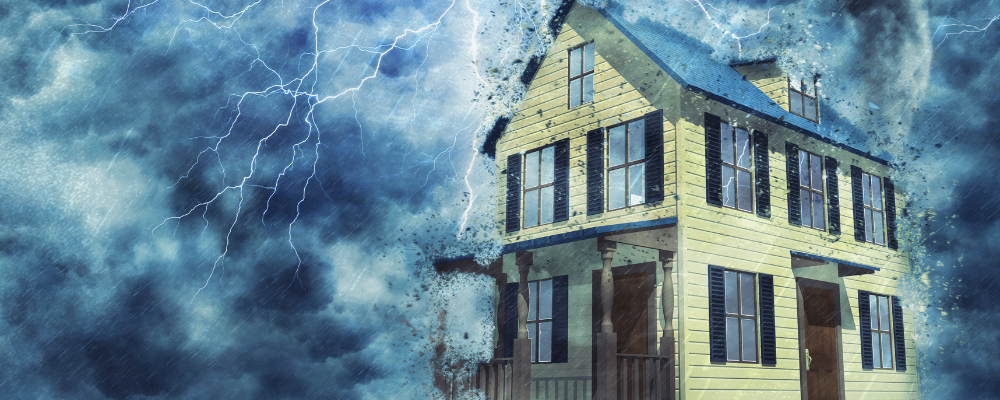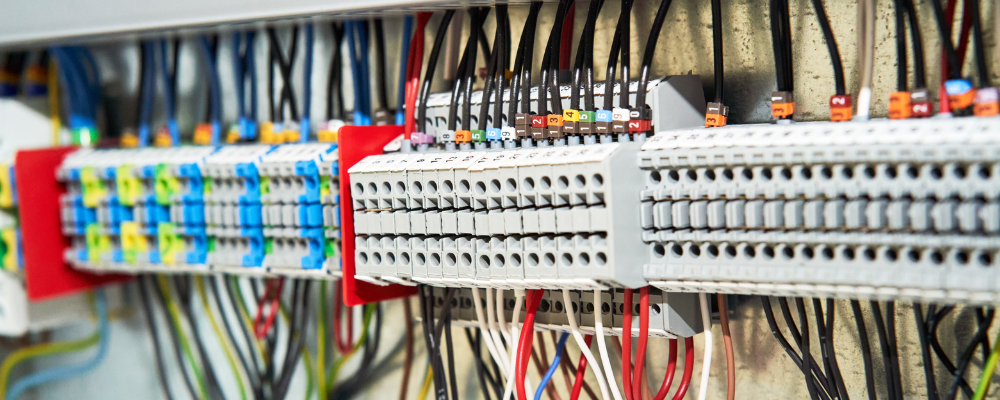Pinellas County Electricians Your Local Panel Pros
Fully Licensed and Insured
FL State Lic: EC13004964
CALL FOR A QUOTE - (727) 626-3414
Blog
ROARING VOLTS

By Kevin Byrne
•
08 Jul, 2024
Hello, friends and family! Kevin here, your neighborhood panel pros. Let's talk about surge protection. First, let's break down what a surge protector actually does. It's like a bouncer for your electrical system, standing guard to keep out any unwanted spikes in voltage. When a surge protector detects a sudden increase in voltage, it diverts the excess power to the ground, preventing it from frying your precious electronics. It's like a superhero saving the day, one voltage spike at a time! Now, let's talk about what happens when lightning strikes. It's like a giant bolt of electricity shooting through the air, looking for the path of least resistance to the ground. If your home is in the way, you could be in for a world of hurt. But don't worry, we're here to help! A surge protector can come in different forms and help protect your home from lightning strikes in a few ways. Lightning Rods: Think of these as the ultimate lightning repellent. They're designed to attract lightning and provide a safe path for the electrical current to travel to the ground, away from your home. It's like giving lightning a VIP pass to the ground Surge Protection: As we mentioned earlier, surge protectors can help prevent power surges caused by lightning strikes from damaging your electronics. They're like the ultimate power-up for your electrical system! Grounding Systems: These work in tandem with lightning rods and surge protectors to provide a safe path for lightning to travel to the ground. It's like creating a superhighway for lightning to travel safely away from your home. Now, let's talk about the importance of whole-home surge protection . It's like having a team of bodyguards for your electrical system. By installing a whole-home surge protector, you can protect your entire home from power surges caused by lightning strikes, power outages, and other electrical disturbances. It's like having an invisible force field around your home A surge protector can be a valuable tool in protecting your home from the wrath of Mother Nature. But remember, it's not a foolproof solution. Lightning is a powerful force, and sometimes even the best surge protectors can't stand up to its might. So, be sure to take other precautions, like installing lightning rods and grounding systems, to give your home the best possible protection Stay safe out there, folks! And remember, when it comes to protecting your home from lightning, We've got your back at Pinellas County Electric, call us at (727)626-3414.

By Kevin Byrne
•
02 Jul, 2024
Hello, fellow Floridians! Kevin here from Pinellas County Electric , your friendly neighborhood electrical contractor. If you’ve ever wondered what’s going on behind those mysterious panels in your home, you’re not alone. Today, I’m shedding some light on circuit breakers – those unsung heroes of electrical safety – and the not-so-heroic symptoms they might exhibit when they’re in trouble. Grab your tool belt (or just a cup of coffee) and let’s dive in! 1. Frequent Tripping: More Annoying than a Mosquito in July Does your circuit breaker trip more often than you do on vacation? If you're resetting it more frequently than you’d like, it's trying to tell you something. Frequent tripping can be a sign of overloaded circuits, short circuits, or even a ground fault. It’s like your breaker’s way of waving a little red flag and saying, "Help! Something’s not right!" 2. Burning Smell: Eau de Electrical Fire If you catch a whiff of something burning near your electrical panel, that’s a big, flashing neon sign that you’ve got a problem. A burning smell could indicate overheated wiring or components, which is not just bad news – it’s dangerous. Don’t ignore it; get it checked out ASAP! 3. Flickering Lights: The Ghost of Electrical Problems Past Sure, flickering lights can add ambiance to a spooky story, but in real life, they’re more creepy than cool. If your lights are doing the flicker dance, it could mean your circuit breaker is struggling to keep up with the load. It might also indicate loose wiring or a problem with the breaker itself. 4. Hot Breaker Panel: Toasty is for Toasters, Not Breaker Panels Feeling the heat? If your breaker panel is warmer than your morning toast, that’s a red flag. Breaker panels should not get hot; if they do, it means there’s excessive current flow or a malfunctioning breaker. In either case, it’s time to give us a call. 5. Old Age: Not Just for Wine and Cheese Circuit breakers, like us, don’t age like fine wine or cheese. They have a lifespan, and if yours are getting up there in years, they might not be as reliable as they used to be. An aging breaker can fail to trip when it should, leading to potential electrical hazards. If your home is sporting vintage breakers, it might be time for an upgrade. 6. Physical Damage: Breakers Aren’t Boxers If your breaker panel looks like it’s been in a bar brawl, it’s probably time for some TLC. Physical damage to breakers or the panel can compromise their ability to function properly. Dents, cracks, or corrosion are all signs that it’s time to call in the pros (hint: that’s us!). 7. Strange Noises: Your Breaker Panel Shouldn’t Hum Like a Karaoke Bar Humming, buzzing, or any other strange noises coming from your breaker panel are not normal. It’s not trying to start a band – it’s likely trying to tell you there’s an electrical issue. Loose connections or failing components can cause these noises, and they shouldn’t be ignored. When in Doubt, PCE It Out! If you’re experiencing any of these symptoms, don’t wait for a circuit breaker meltdown to ruin your day. At Pinellas County Electric , we’ve got the expertise and enthusiasm to handle all your electrical needs with a smile and a touch of humor. After all, keeping your home safe and sound is our top priority – and we like to have a little fun along the way. Stay safe, stay powered, and remember: when it comes to electrical issues, PCE is your go-to team. Give us a call or drop by our office in Clearwater. We’re always here to help, one circuit at a time! Till next time, keep those lights shining bright and those breakers in check! Cheers, Kevin from Pinellas County Electric

By Kevin Byrne
•
26 Jun, 2024
Hey there, friends of Pinellas County Electric! With storm season upon us, it's more important than ever to be prepared for the unexpected. As you know, power outages can strike at any time, often when we least expect them. But fear not! We've got a handy tip to keep you in the know and ahead of the game. Introducing the National Power Outage Map Tracker – your new best friend during storm season. This nifty tool gives you real-time updates on power outages in our area, helping you stay informed and prepared. Just click on the link below to check out the outage map for Pinellas County: National Power Outage Map Tracker - Pinellas County, FL Why is this so awesome, you ask? Well, here's a quick rundown: Real-Time Updates: Get the latest info on power outages as they happen. No more guessing games! Interactive Map: See exactly where outages are occurring in Pinellas County. It's like having a storm radar for your power! Stay Connected: Knowing the status of power in your area helps you plan better and stay connected with loved ones. At Pinellas County Electric, we're all about keeping you safe and prepared. So, bookmark that map, share it with your neighbors, and let's weather this storm season together with confidence and a dash of humor. Remember, a little preparation goes a long way! Stay safe, stay powered, and as always, keep the lights on (when you can, of course!). Cheers, Kevin Pinellas County Electric

By Kevin Byrne
•
09 Jun, 2024
Hey there, wonderful readers! Hurricane season is upon us, and while we can't control the weather (yet!), we can definitely help you get ready for it. At Pinellas County Electric, your safety is our top priority, and we believe that a little preparation goes a long way. To make storm prep a breeze, we’ve put together a fantastic, free eBook: “Ride Out the Storm: Your Ultimate Guide to Hurricane Preparedness.” It's packed with practical tips, essential checklists, and just enough humor to keep things light. Because let’s face it, a little laughter can make even the stormiest days brighter! What’s Inside: Storm Categories Demystified: Because understanding your frenemies is the first step. Home Fortification Tips: Turn your home into a fortress against the winds. Emergency Kit Must-Haves: All the essentials, plus a few fun extras (chocolate, anyone?). Evacuation Planning: Get your route sorted so you don’t end up in Timbuktu. Safety Tips During and After the Storm: We’ve got your back through it all. Why wait until the sky turns grey? Download your free guide now and become the hurricane hero of your household.

By Kevin Byrne
•
28 Mar, 2024
As a homeowner, knowing how to reset a circuit breaker is important in case of sudden power outages. Circuit breakers are essentially switches that control the electrical wiring that power your appliances and fixtures. The switches turn off automatically if a short circuit or electrical surge occurs or too much current is flowing through the wires. If one part of your house suddenly loses power, there is a high chance that it is caused by a tripped breaker. If your circuit breaker trips and you do not know how to reset a circuit breaker, you will need to call a professional electrician to help you fix the problem. However, resetting a tripped circuit breaker is not as complicated as it sounds, and knowing how to do it can come in handy in many cases. Continue reading to learn about how to reset a circuit breaker and what issues may cause your breaker to trip even after resetting it. How to Reset a Circuit Breaker First and foremost, you must wear safety glasses and ensure that the floor is dry to avoid getting shocked and injured. Unplug all the appliances in the affected room or area, then open your circuit breaker panel. Look for the switch in the center position, flip it to the off position, then flip it to the on position. Make sure the breaker switch stays on because if it trips again after you reset it, you must call your electrician since you may have a serious wiring problem. Potential Circuit Breaker Problems Besides knowing how to reset a circuit breaker, it also helps to know the possible issues that can trip your breaker. The most common causes are: Short Circuit A short circuit occurs when a hot wire touches a neutral or hot wire, causing excessive current to flow through it. This issue can be dangerous if left unaddressed, so it is best to get professional electrical services to prevent potential house fires. You can try checking your power cables and outlets to see if there is any discoloration or melting. However, if you cannot detect the problem, you must call an electrician. Overloaded Circuit An overloaded circuit is one of the most common causes of a tripped breaker. It essentially means too much current is flowing through the breaker, causing the switch to turn off. If this is the cause of the problem, try checking the appliances plugged in the affected area. You may be consuming too much power than you realize, so make sure to unplug the devices that are not in use. Generally, this should solve the issue, but if your breaker still trips, you can call an electrician to check your wiring and installation for possible loose connections. Ground Fault A ground fault is similar to a short circuit, but what happens here is a hot wire touches a ground wire. This problem is often caused by damaged wiring or old appliances, which causes electricity to take a path through the ground. If this is the cause of the problem, you may feel an electrical shock from touching some appliances. Call Your Electrician Today Maintaining your electrical systems and wiring is important to keeping your home safe. Contact us today at 727-88-VOLTS to schedule a free consultation with a licensed electrician. We can help you diagnose the problem and fix it immediately to prevent further issues from arising.

By Kevin Byrne
•
02 Mar, 2023
Being a homeowner is like riding a rollercoaster. Fun, a bit of a challenge, and there’s always something new around the corner. One such twist? Getting to know your electrical service panel – the unsung hero that sends power zipping around your cozy abode. Think of the electrical panel as the maestro of your home’s symphony. It’s the genius that connects the electrical vibes from the outside world to the groovy music in your home, or in other words it manages the electricity from the electric company and distributes it throughout your home. So, it’s super important to get to know your panel, and when you do you’ll be one step closer to becoming a home-electricity wizard. Finding That Elusive Panel Now, your electrical panel is a bit of a shy type. It usually hides in spots like the garage, basement, utility closet, or even in the sneaky kitchen pantry. Those with vintage homes? Peek outside. It might just be chilling on an exterior wall. A Peek Inside the Panel Pop open that panel door and voila! Main Circuit Breaker: It’s like the head honcho of the gang. Shut it off, and your home goes into power nap mode. Circuit Breakers: Your panel’s little soldiers. They come as single-pole for 120 volts and double-pole for 240 volts – ideal for those appliances that like a bit more juice, like your trusty air conditioner. Sub-panel: A fancy add-on if you’ve got a generator or extra breaker space. Panels come with style and size. Ranging from 100 amps to a whopping 400 amps, the modern home usually rocks at least a 200 amp because, well, who lives without a heater or AC? Panel Types 101 Main Breaker Panel: Your everyday, standard panel. It’s all about controlling and distributing power. This is the most commonly used panel type, which controls electricity that flows into each of the areas in your home. It is designed to distribute a certain amperage to each circuit and cut power when needed to prevent overheating. Fuse Boxes: These bad boys use fuses to keep everything in check. When excess current flows through a particular circuit, the fuse shorts out, so you have to make sure they allow enough current to flow to your appliances and keep an eye on ’em! Main Lug Panels: These panels have lugs that the line wires can run into, so they do not have a main breaker. You can connect the main lug to your main breaker to act as a sub-panel, with the latter being a separate disconnect. Transfer Switches: Got a generator? These switches will transfer power from the generator to the electrical power in the main panel to supply power even during outages. Getting regular check-ups, at least once a year will ensure safety and give it a long life of 20-30 years! Give Pinellas County Electric a buzz at 727-88-VOLTS to ensure all’s smooth and zappy.

By Kevin Byrne
•
12 Mar, 2022
Commercial buildings service several people on a daily basis amounting to hours of prolonged electricity use that may require complicated wiring systems. These establishments become prone to electrical errors, so it is a good practice to perform routine checks to ensure the safety and effectiveness of your electrical sources. But, before you find the need to hire electrical services in buildings, what are the common commercial electrical problems found in commercial buildings? Flickering Lights: Flickering and dimming lights can strain the eyes of your employees and delay the accomplishment of tasks. To properly carry out daily operations, a commercial building will require working lights. It’s common for light bulbs to burnt out. Your electrical system can be checked through general troubleshooting. Electrical services in buildings may be needed to check for a loose connection in the circuits or repairing faulty wiring that the common individual can overlook. Power Loss and Damage to Appliances: Among the electrical issues commonly faced by a commercial building, an unexpected power loss can be a major problem. A power outage could leave your building without heating or air conditioning, can damage appliances, and possibly miss out on potential customers. If backups are not set in place, your company could suffer from information loss due to the lack of an electrical supply. Overloaded Electrical System: After a power failure, there can be instances wherein breakers trip if the circuits in the electrical system are overloaded with the constant use of electrical devices. A professional electrician will effectively assess and repair the electrical system. Commercial electrical services in buildings may be needed to upgrade its electrical work and add a circuit. Faulty Wiring System: Without the help of electrical contractors to execute electrical services, common electrical problems will occur. Faulty installations of commercial electrical systems in buildings can have poor connections and lead to fire hazards. If you install the wrong wire length to connect equipment in your electrical system, it could lead to short circuits. A professional commercial electrician should perform electrical work so you can be sure that your light bulbs, heaters, air conditioning, and other appliances are installed correctly. Overheating Equipment and Switches: If your equipment and switches become unusually hot, this common electrical problem may lead to a power failure or electrical breakdown. Wires can melt or burn with continuous plugging of appliances into outlets with visible sparks. Loose connections are a common commercial electrical problem that is often overlooked, which can lead to overheating and cause accidents or create possible fire hazards in the workplace. Protect your employees from slip hazards by hiring electrical services in buildings that can provide suitable fixes and prevent further damages to your electrical system. Short Circuit: The misuse of electrical equipment may call for electrical services in buildings. If an employee uses an appliance with a faulty cord or a damaged extension cord, this can lead to a short circuit. Wirings without the proper protection can easily be tampered with by natural elements and humans that can greatly affect the power supply, and lead to fire hazards. A ground fault: This can also happen if an employee uses an appliance without proper insulation. If you plan to upgrade your office, such as installing new outlets, you should hire a reliable electrical contractor for the renovations. The safety of your commercial building and employees is top priority, therefore regular electrical inspections is prudent. Contact Pinellas County Electric at 727-88-VOLTS and let us provide your electrical services in buildings and perform the proper maintenance, repair, and replacement of your electrical system!

By Kevin Byrne
•
01 Mar, 2022
Home inspections are vital when shopping for a home or planning a renovation. Inspections give you a clear picture of the condition of a house and problems that may affect the sale price or remodeling project size. While home inspectors generally look into different aspects of the property, it is often recommended to also get an electrical home inspection to pinpoint problems that may have been overlooked. As the name suggests, a specialized electrical inspection focuses more on checking the integrity of electrical systems and wirings in place. Assessing these areas is especially important since problems related to them can lead to safety risks. With a qualified electrician to do the job, you can take immediate action by updating wirings or replacing circuit breakers to maintain safety at home. When hiring a professional to conduct an electrical home inspection, here are some of the most common issues that usually arise during the check: Service Panel Issues Every home’s electrical service panel serves as the central source of electricity, so any problems related to it can easily compound to bigger concerns later on. Some issues may be observed in an inspection include loose or double-tapped circuit breakers, lack of the main disconnect switch, or an overall damaged panel. Circuit breakers in older homes can be particularly faulty as they were not designed for the electrical needs of more advanced appliances. This may result in frequent tripping due to your breaker panels overloading from their inability to manage the amount of electricity flowing through. Improperly Wired Switches Perhaps one of the most common issues found in an electrical home inspection would be improperly wired switches. In most cases, this happens when a non-professional or poorly trained electrician does the wiring and mixes up the neutral and hot wire slots. When this happens, it causes an issue known as reverse polarity, which can cause potential shock hazards. Aluminum Wiring While it may not seem like an issue, aluminum wiring can be a cause of concern since aluminum is not as effective a conductor as copper. Overall, the metal can become defective quicker, so the longer it is used, the higher the risk of fire hazards. Due to this, many home insurance companies opt not to insure homes that are wired in aluminum. Lack of GFCI Protection GFCI, short for ground fault circuit interrupters, are required in kitchens, bathrooms, laundry rooms, and other places with moisture and where the outlet may come into contact with liquid. These outlets are safety standards set in building codes to minimize the risk of shocks and burns in any home. Given the number of people who go in and out of the affected areas, it must enforce stricter GFCI protection throughout your home. Through a professional electrical home inspection, you can double-check to see if your home’s GFCI outlets are working properly, installed correctly, or need replacements to prevent bigger problems from arising. Knob-and-Tube Wiring Similar to the issue on aluminum wiring, knob and tube wiring is one of the older variants of electrical wiring used back in the early 1900s. While it is not inherently dangerous, it can be highly risky since it does not use a ground wire and thus cannot accommodate three-pronged electrical devices. Knob and tube wiring also uses rubber, as opposed to plastic, as an insulator, which can break down over time and cause issues like overheating and shock or fire risks. Overuse of Extension Cords Extension cords can be convenient to plug in multiple devices at a time, but you have to be careful not to get over-reliant on them. The national electric code requires that homeowners reduce the use of these extension cords since doing so can increase the likelihood of tripping hazards and other safety concerns. If a home is found to be using these extensively during an electrical inspection, it is likely a sign of having insufficient power outlets. Schedule an Electrical Home Inspection Today With Pinellas County Electric A thorough inspection from a professional electrician in Pinellas County can help you check what problems need to be addressed in a home. Whether you are remodeling your place or looking to purchase a home, you want to make sure your property is in its best condition. Learn more about what Pinellas County Electric offers by calling us at 727-88-VOLTS to schedule an inspection. With over 150 years of combined experience in the industry, we can guarantee that our team can solve your electrical concerns.

By Kevin Byrne
•
28 Feb, 2022
People tend to underestimate the potential risks of electricity. Home electrical fires are a danger in many communities because people use electrical devices daily, such as light fixtures and appliances. From 2012 to 2016, the second leading cause of U.S. home fires were electrical failures, according to the NFPA. It was also reported that home electrical fires resulted in the most civilian deaths and more than a billion in property damage. The majority of electrical malfunctions that started residential fires occurred during cold weather months from November to February. Here are some tips on how to stop a fire caused by electricity in case of an emergency. Turn off the main switch of the fuse box: If you can identify which electrical device caused the fire, safely handle the electrical cord and outlet, then unplug it to turn off the electrical flow to the device. You should also turn off the circuit breaker or the main switch of the fuse box. Do not use the appliance after the fire has been put out because the electrical wire has been damaged. An electrician can check the fire source caused by electricity and prevent a future electrical fire from happening. Use baking soda: Faulty wiring and installation can start a fire. Did you know that a common household item can be used to stop fires? If you cannot locate your fire extinguisher, you can use baking soda to stop a fire caused by electricity. Sodium bicarbonate can smother a small fire: If you have a heavy piece of cloth such as a blanket or thick coat, you can remove the oxygen source and put out a small fire. Do not leave your space heaters in an unattended room. Please do not keep your space heaters on while you are sleeping as they can lead to a fire caused by electricity. Do not try to extinguish electrical fires using water: To prevent electrical fires from worsening, remember not to use water to put out a fire caused by electricity.You can risk getting electrocuted because water is a natural conductor of electricity. Water may also be used to spread the fire and potentially burn flammable materials that can shock residents. Understand the category of your fire extinguisher: Be aware that fires have certain classifications. Electrical fires belong to the Class C category of fires to need a fire extinguisher appropriate for this type. After putting out the fire: Verify that your fire extinguisher has the proper label and certifications. Check-in with your fire administration and make sure you have the updated contact details of the emergency electrical services. You never know when you may need their assistance. Install safety alarms: As a good safety practice, you may want to install quality smoke detectors and fire alarms in your residential and commercial spaces. There are fire alarms that can contact your fire administration in the event of an emergency and increase the chances of surviving a fire caused by electricity. Hire a pro: If you notice that your appliances and light bulbs get unusually hot on several occasions, request that your electrical service check your electrical systems for loose wires that may need repairs. The common causes of electrical fires are poor maintenance of electrical systems, and the leading cause of electrical fires is overlooked minor damages. A fire caused by electricity may be due to faulty electrical outlets. Older homes may have worn out sockets that have not been regularly maintained. Back in the day, older circuit breakers handled light bulbs and minor appliances , but now the electrical system of a modern home is much different. More appliances such as washing machines, video game consoles, computers, and air fryers consume a lot of electricity. You may need to request the help of residential electrical services to check the breaker boxes and perform panel changes to upgrade your electrical system and protect your home from a fire caused by electricity. Useful Commercial Building Tips If you have space in a commercial building, you may want to hire commercial electrical services to complete a thorough inspection of your complex electrical systems, such as your electrical wiring, electrical outlets, and power panels. Professionals would have the necessary licenses to do the electrical work, and an updated electrical system can prevent a fire caused by electricity. There are several ways you save lives and minimize the damage due to a fire caused by electricity. Being proactive can help prevent fire hazards and give you the peace of mind that you are safer in your homes and workspaces. Contact Pinellas County Electric at 727-88-VOLTS and let us prevent a fire caused by electricity while taking care of all your electrical needs.

By Kevin Byrne
•
26 Feb, 2022
Protect your home and appliances with a house surge protector. Being a homeowner comes with various responsibilities, including ensuring your and your family’s safety. To do this, you can perform regular inspections on your plumbing system and electrical systems and do general home maintenance. Electrical work, in particular, can be challenging because of the safety risks involved in managing wiring and installation and general appliance usage. Without the right measures in place, your home may become vulnerable to fires and other dangers. Installing a house surge protector can be beneficial in more ways than you may think. Power surges can occur for many reasons, including weather conditions like lightning strikes or a faulty circuit breaker. Additionally, with technology being more heavily utilized in today’s digital age, it is no surprise that power consumption has risen for many homes. With a house surge protector, you can effectively manage your home appliances and electronic devices. A power strip is often used to connect multiple electrical devices to a socket, and while it looks similar to a surge protector, it does not prevent irregular voltage spikes from occurring. Get to know more about surge protection devices and why installing them in your home can be highly beneficial. What is a House Surge Protector? Protecting your appliances and electronics at home is crucial to prevent them from burning out and getting damaged. With a house surge protector, you can essentially achieve this as the device limits any excess current and blocks its flow to keep your appliances in good condition. You can think of it as a pressure relief valve that allows current to flow through. If the voltage levels are higher than usual, the excess current is shorted to the ground. Whole house surge protectors are installed on your circuit panel, and the process usually takes about two hours for a professional electrician. Having the installation completed professionally is essential since it requires proper wiring and grounding, which can be difficult to do without the proper skills and expertise. If you make mistakes during the installation, you can risk causing damage to your home. Causes of Electrical Power Surges Electrical power surges are essentially power spikes that increase the voltage of current flowing through your appliances and electronics. They can originate from inside your home, such as when you are turning high power appliances on and off or if you have faulty wiring that cannot withstand the surge. They can also originate from outside your home; downed power lines and lightning strikes are the more frequent causes. The damage from lightning-induced surges can be massive and significant if the lightning strikes less than a mile from your home. However, these instances are not as common as they sound, and in many cases, up to 80% of power surges occur for more minor reasons from inside your home. The mere cycling of on and off of some of your appliances can cause smaller power surges. While they may seem harmless, the frequency of the surges can compound and damage your electronics over time. You may not notice the damage caused by the minor surges since they are transient, but over time, they can shorten the lifespan of your appliances. The next thing you know, they suddenly stop working. The last thing that you want is to invest in high-quality electronics that get damaged quickly, so getting a house surge protector can protect your devices from voltage spikes from the power surges. Benefits of Whole House Surge Protection Aside from the primary benefit of protecting your appliances and devices from surges, whole house surge protection also comes with other advantages, including: Layering Surge Protection If you have complex and expensive electrical systems in your home, it will be helpful to layer your whole house surge protection. If an appliance sends a surge to a shared circuit, this can also harm your other outlets. With layered protection, all your circuits can get proper protection from surges, so you can avoid damaging any of them. Complete Electrical System Protection Whole house surge protectors will not only keep your appliances safe but also protect your electrical system as a whole. With technology becoming a norm today, you likely have many appliances at home. As such, guarding all your outlets and protecting all the electrical equipment is a must. Versatility and Flexibility Surge protection systems come in various options to suit your home’s voltage needs, so they can cater to all homeowners. Choosing the right whole-house surge protection is important since your home may have a voltage limit based on its size. For example, a standard and traditional home should not get a surge over 10kA, but if you would like to ensure you get adequate protection, you can ask your electrician for options. Keep in mind that there are also several brands to choose from, and warranties may differ based on your provider. Thus, browsing through many offers thoroughly will be helpful before making a final decision. Protection from Risks Electrical surges can be harmful to not just your devices but also your homes as they may sometimes cause risks like fires. By getting a whole house surge protection system, you can maintain your home’s safety and curb damages caused by violent external conditions or other factors. Get Whole House Surge Protection Today Interested in installing a house surge protector to protect your appliances and electronics today? If so, contact us today at (727) 88-VOLTS to request your electrical service and get in touch with us. Our team will gladly assist you through the process and help you determine the appropriate services and equipment for your home. Take action today and allow an electrician in Pinellas county to solve your electrical issues so you can ensure your home is safe for all. With whole house surge protection, you can prolong the life of your appliances and combat damages caused by power surges.
Content, including images, displayed on this website is protected by copyright laws. Downloading, republication, retransmission or reproduction of content on this website is strictly prohibited. Terms of Use
| Privacy Policy





